Leadership
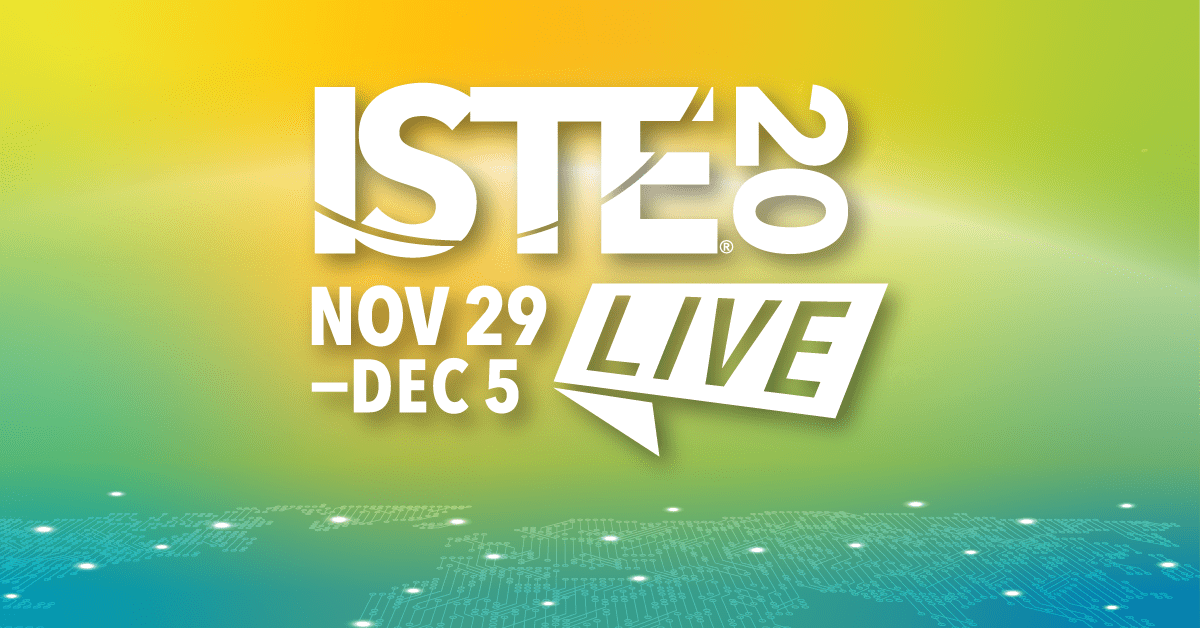
*This post has been written as part of my professional growth plan through my #ISTE20 scholarship.
Edtech Coaches Panel: effective strategies to improve teaching & learning
Presenters: Kris Amijo, Jason Gay, Stephanie Howell, Amy Hudson Estepp, Brian Seymour, Jeremy Shorr
Overview: “A technology integration specialist and coaches panel from a variety of educational settings will share challenges and strategies that contribute to a district’s technology vision, implementing high-quality, job-embedded professional learning opportunities and integrating digital literacy and citizenship.”

Main Takeaways:
- All support roles in a division exist to support teachers in their role with students
- How can we get teachers to think like K-1 students? (curious, ready to learn, natural engineers)
- Models like TPCK can provide a framework for coaching
- Face-to-face instruction provides more options for teachers to pause, reflect, and build relationships
- Don’t forget to model and continue this when digital
- Ed tech coaches should be out in person, building relationships with their stakeholders
- There is not a one-step fix to ed tech problems
- Clear communication with parents/families is key
- Help parents/families learn the platform
- Understand expectations, strategies, etc
- When starting off as an ed tech coach:
- build relationships
- start with those that are interested
- phrase your language effectively
- DO: “I am really missing the kids, can I come spend some time with you”
- DON’T: “I am coming in to do x”
Further Resources:
- Session website (resources and contacts)
- Continue the conversation by following the #ISTETC on Twitter
- Gizmos
- Google Coaching PD
Level Up! 10 Essential science of learning principals for instructional leaders
Presenters: Dr. Angela Elkordy, Dr. Ayn Keneman
Overview: “Instructional leaders and coaches will discover how to locate, select, evaluate and implement the most instructional strategies based on findings from the learning sciences! Join us as we share 10 impactful principles that promote meaningful, lasting learning. Session is based upon Design Ed: Connecting Learning Sciences Research to Practice (ISTE).”
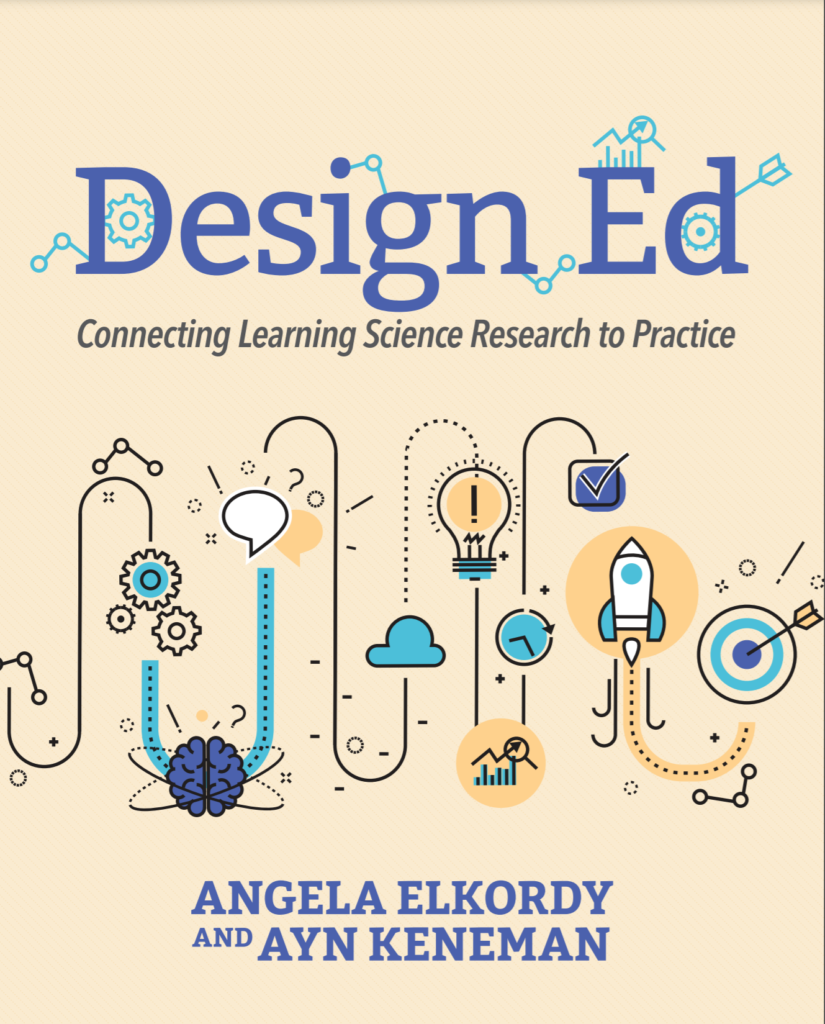
Main Takeaways:
- How do you define learning?
- There has been a disconnect between ed research and practice in the field
- Learning science has been designed to bridge the information and classroom practices
- Science of Learning
- Improving classroom practices and applicability of research
- Translational/practical nature of the science of learning
- Interdisciplinary in nature
- Focus in on the learner and learning vs. teaching
- Locate, select, evaluate, implement
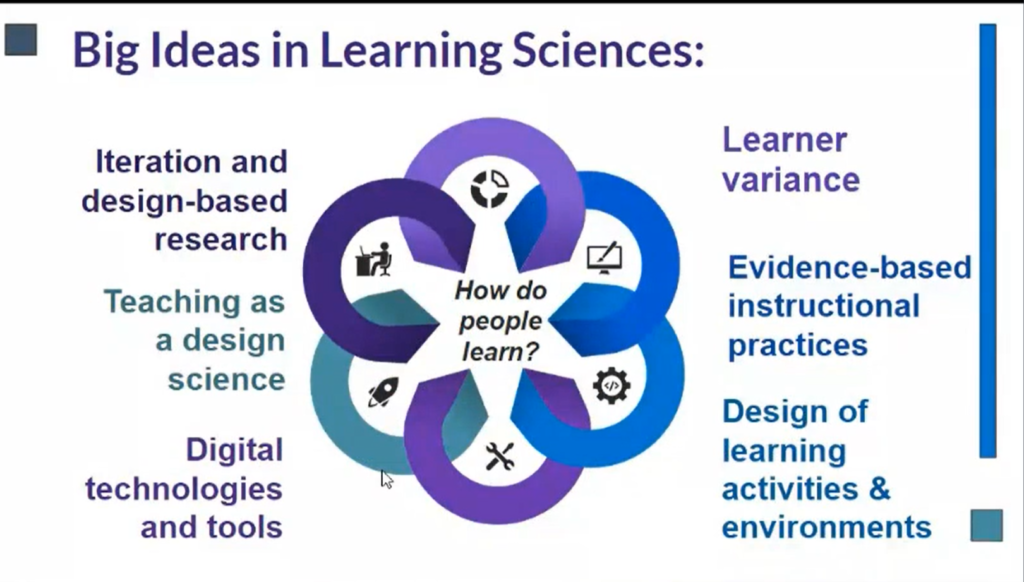
- Takeaways from Learning Sciences
- 1. Impactful teaching and learning practices
- what are high leverage practices?
- what is learner variability?
- 2. Teaching as a design science
- Design of the learning activities and the environment(s)
- 3. Powerful instructional problem solving
- How can digital tools help?
- 1. Impactful teaching and learning practices
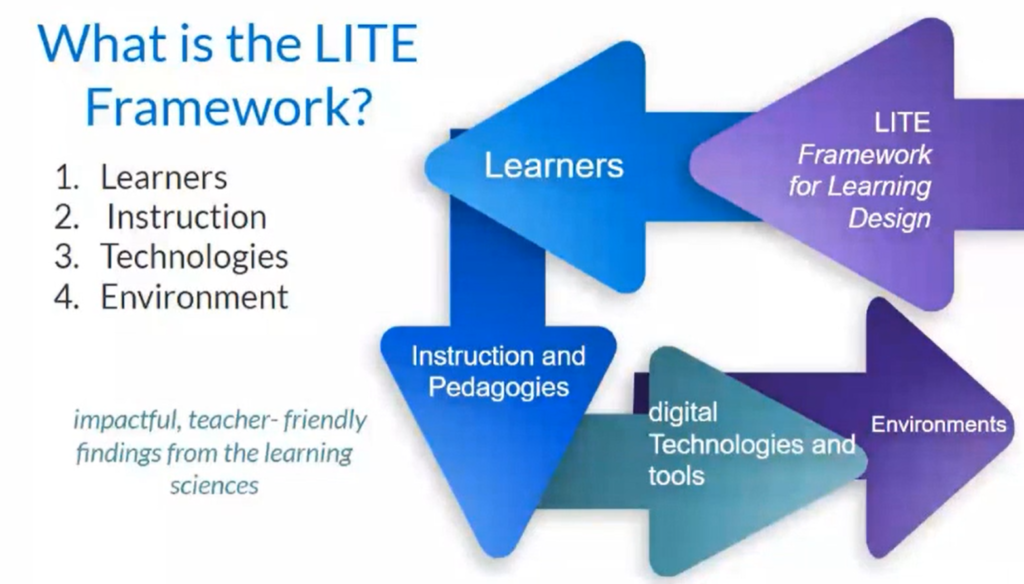
- Big Idea #1: Know Your Learners
- develop relationships on trust
- observe
- ask
- formative assessment
- Big Idea #2: Know Your Instructional Impact
- high leverage practices for instruction (HLP)
- evidence of impact, how will it inform next steps
- learning design is not just lesson plannng
- digital age learners
- Big Idea #3: Effective use of digital tools and technologies
- Know your level (using your locally used framework Blooms, SAMR, TPCK)
- leverage tools for deeper learning
- Big Idea #4: Designing Learning Environments
- socio-cultural contexts of learning
- design your teaching/learning space
Further Resources:
- Dr. Elkordy’s Science of Learning for Educators pearltrees curation
- Presentation Slides
- Design Ed book excerpt
There’s No “I” in Edtech: Realizing your vision through team-based PD
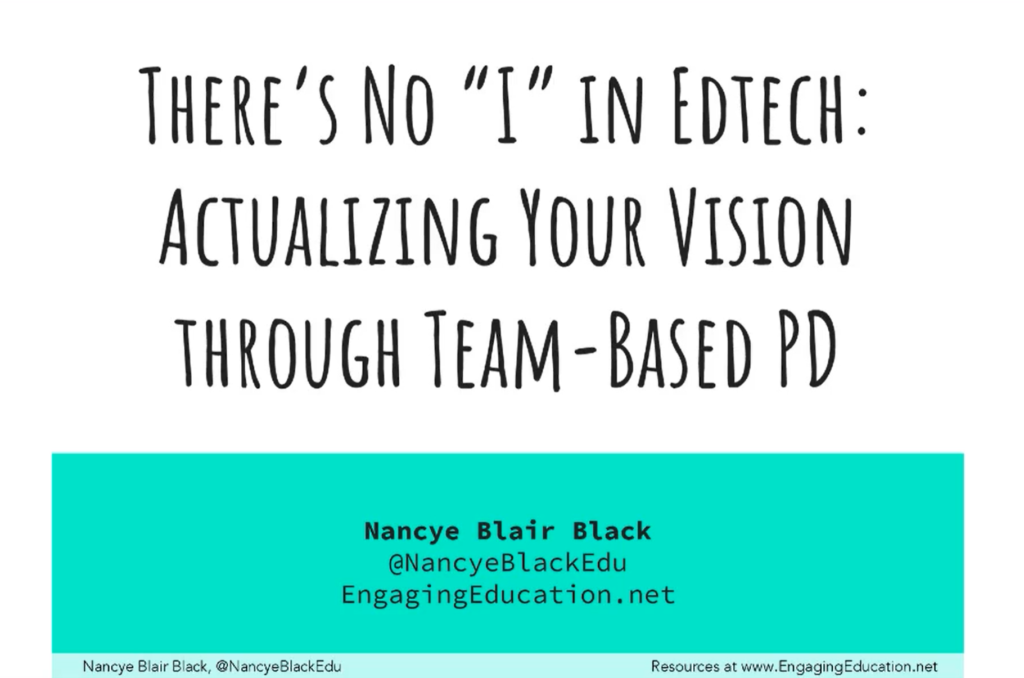
Presenter: Nancye Blair Black
Overview: “Discover how school and district team-based professional learning can improve the buy-in and collaboration needed to achieve a shared vision around integrating educational technologies. Learn best practices and strategies from proven team-based PD initiatives that can be easily integrated at your own school or district.“
Main Takeaways:
- Shared vision is at the heart of transformational change
- How you accomplish that may look different but the end goal is the same
- 5 Vital Strategies for Vision-Effecting Team-Based PD
- 1. Inviting stakeholder input
- get as many people as possible on the same page and talking about the same thing
- blueprint process that includes all stakeholders: students, community members, teachers, all staff
- 2. Create mixed teams
- small but diverse teams
- introduce different positions, different buildings, different backgrounds
- 3. Flip your PD
- Independent professional learning activities
- Complemented with in-person PD and coaching
- 4. Cooperative learning tasks to build trust
- 5. Showcase and celebrate success
- finding people in your organization who are doing your vision well
- let them share
- 1. Inviting stakeholder input
How Covid-19 accelerated the digital transformation of education
Presenters: Hardeep Gulati, Kimberly Nidy, Dr. Donald Robertson, Tracy Smith, Dr. Akilah Willery
Overview: “PowerSchool CEO Hardeep Gulati brings together some of the nation’s top education leaders to discuss how the pandemic has dramatically accelerated the digital transformation in education. Together, they’ll discuss how they are addressing challenges through these times and the path ahead as they navigate the current school year and beyond.”
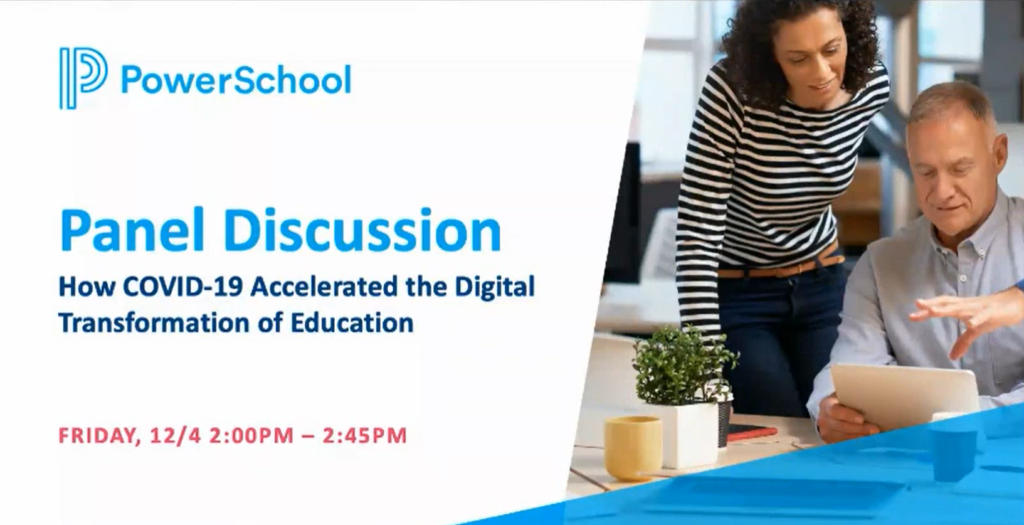
Main Takeaways:
- How is your district addressing the unique challenges of back-to-school 2020?
- You will always have a distribution of staff comfort with embracing technology
- Pick one LMS platform to serve as your “hub” for consistency with all staff/families/programs
- Clear communication on scheduling and attendance for schools and community
- Just because it is “tech” does not mean it is good or that it is good for students
- Find what is best for your students and sustainable for instruction
- Integration of programs allows for data to be in one place for educators to better identify trends, outliers, and act proactively
- Feedback is essential at all levels (teacher to student/family, student/family to teacher, teacher to admin, admin to teacher, etc)
- Learning should be the constant and time should be a variable
- If you hear, “the students will be behind” think compared to who? Is this an effective concern during a global pandemic?
- How can this be a transformative moment in educational history?
- We can identify a pocket of students who thrive out of our buildings and there is now a viable option for particular subsets
- Adding in more options for students and strengthening community partnerships
- Better understanding of societal needs (teachers, students, families)
- Better understanding of teacher strengths and weaknesses to inform future planning
What superintendents need from their technology leaders: collaborating for success
Presenters: Dr. Mark Benigni, Dr. Doug Brubaker, Ann McMullan, Dr. David Schuler, Dr. Donna Wright, Dr. Randy Ziegenfuss
Overview: “Leadership is key to any school district’s technology initiatives. Join five leading superintendents as they engage in a lively, informative discussion on the challenges and rewards of leading digital transformations – especially within our current learning environments – and how they bring everyone together in collaboration that leads to success.”
Main Takeaways:
- 1. Who are your technology leaders?
- Coordinator of ICT, Director of Technology, Instructional Coaches (every area uses a different name)
- There needs to be a technical support team and an instructional support team (both present and working together)
- Teachers
- Students
- 2. CTO “Chief Technology Officer”: Recruiting, Interviewing, Hiring
- Evidence of appropriate background in both educational and technical capabilities
- Succession planning: willingness for ongoing learning
- 3. CTO: Primary Areas of Responsibility
- Engagement with teachers
- Identify redundancies
- Willingness to learn, adapt, and try new things safely
- Long-term planning
- Willingness to train and modernize other departments like maintenance, transportation, etc
- Identify trends
- 4. CTO: Leadership & Collaboration
- Include CTO in other instructional and planning committees
- Transparency
- Clearly identify roles but plan for cross-training to assist with absences
- 5. Best Lessons Learned
- Things change so fast in the field of tech that you need to encourage and support your CTO’s learning plans
- Training for families/community helps teachers/admin/etc focus on instructional and emotional needs
- Ask difficult questions like, “What happens if we are hacked?” to check for long-term planning
Further Resources:
The confluence of K12 education technology leadership
Presenter: Dr. Devery Rodgers
Overview: “The success of school district technology initiatives sometimes rest on the politics of education technology structures within the organization. A study was conducted with senior level technology administrators in over 30 school districts to explore how the confluence of EdTech and IT departments affect the realization of technology initiatives.”
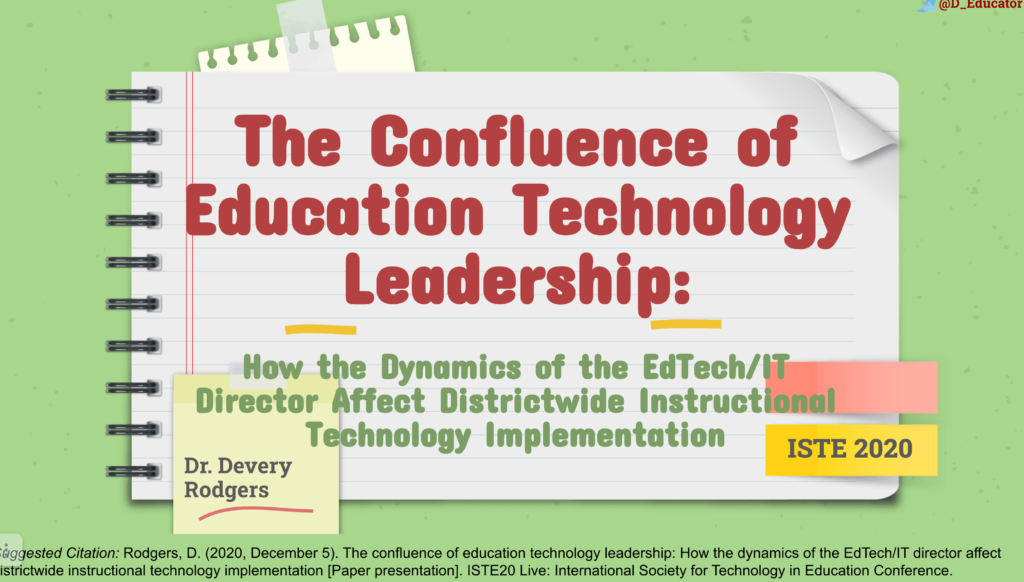
Main Takeaways:
- Education technology: technologies dealing with education
- Instruction technology (ed tech): facilitating learning and improving performance in education technology
- Information technology: dealing with the hardware of technology
- The most optimal environment is to have:
- an instructional technology leader with and informational technology background
- an information technology leader with a background instruction
- or a symbiotic structure
- There is frustration when info tech makes decisions that are easier on the backend but challenging for end users (students)
- How big is the division? What leadership role do they take on? What department are they included in? What funding do they have access to? What is their level of proficiency?
Further Resources:
The next learning topic on my professional growth plan is “Instructional Design & Delivery”.